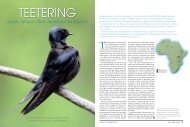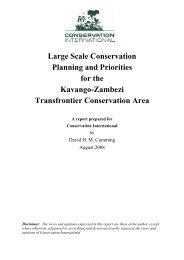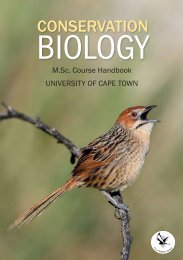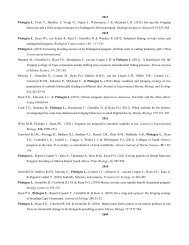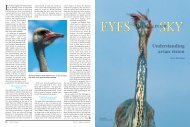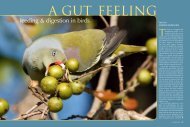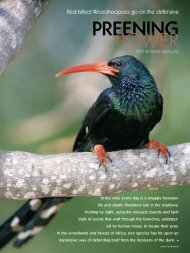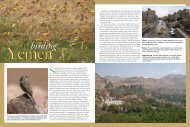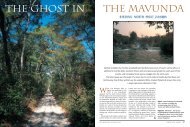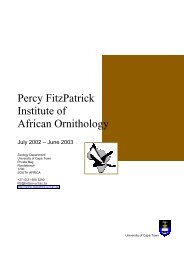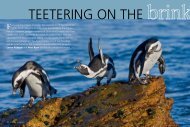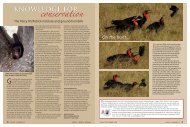Siberian Peregrines in southern Africa
Siberian Peregrines in southern Africa
Siberian Peregrines in southern Africa
- No tags were found...
You also want an ePaper? Increase the reach of your titles
YUMPU automatically turns print PDFs into web optimized ePapers that Google loves.
From Arctic tundras to <strong>Africa</strong>n dunes<strong>Siberian</strong> <strong>Peregr<strong>in</strong>es</strong> <strong>in</strong> <strong>southern</strong> <strong>Africa</strong>Text by Andrew R. Jenk<strong>in</strong>s and Alan StephensonPhotographs by Andrew R. Jenk<strong>in</strong>sAcross its almost worldwide distribution,the Peregr<strong>in</strong>e Falcon Falco peregr<strong>in</strong>usvaries <strong>in</strong> appearance andbiology to the extent that as many as 19 geneticallydist<strong>in</strong>ct races are currently recognized.Populations of these subtly different forms aregeographically separate, and many are essentiallyresident with<strong>in</strong> their respective breed<strong>in</strong>g rangesthroughout the year.However, <strong>Peregr<strong>in</strong>es</strong> liv<strong>in</strong>g at northernlatitudes are forced southward by severew<strong>in</strong>ter conditions on their breed<strong>in</strong>g grounds,and the two northernmost races are highlymigratory. Pairs of F. p. tundrius and F. p. calidusannually vacate their territories on the tundrasof arctic North America and Siberia and travelthousands of kilometres south to spend theboreal w<strong>in</strong>ter <strong>in</strong> the tropics.An adult male calidus Peregr<strong>in</strong>e feed<strong>in</strong>g on a Rock PigeonColumba gu<strong>in</strong>ea on the dunes at Woody Cape <strong>in</strong> South<strong>Africa</strong>’s Eastern Cape.62 PEREGRINE Falconafrica – birds & bird<strong>in</strong>g1997 – volume 2, number 4PEREGRINE falcon63
The secrets of Peregr<strong>in</strong>e migrationExtensive r<strong>in</strong>g<strong>in</strong>g programmes, observations of migrat<strong>in</strong>gfalcons <strong>in</strong> areas where they are particularly concentrated,and studies us<strong>in</strong>g satellite telemetry have unlocked manyof the migration secrets of Alaskan and Canadian tundrius<strong>Peregr<strong>in</strong>es</strong>, most of which overw<strong>in</strong>ter <strong>in</strong> Central andSouth America. However, the orig<strong>in</strong>s, routes and dest<strong>in</strong>ationsof migratory <strong>Peregr<strong>in</strong>es</strong> of the Asian Arctic are poorlyknown. These calidus <strong>Peregr<strong>in</strong>es</strong> are thought to movesouth <strong>in</strong>to central and <strong>southern</strong> Asia, the Middle East and<strong>Africa</strong>. Birds cross<strong>in</strong>g <strong>in</strong>to <strong>Africa</strong> probably pass throughthe Red Sea region before fann<strong>in</strong>g out to travel down bothcoastl<strong>in</strong>es. They are apparently quite numerous on passagealong the coasts of Somalia and Kenya, and havebeen reported us<strong>in</strong>g oil rigs off the Angolan coast as hunt<strong>in</strong>gand roost<strong>in</strong>g sites. Inland <strong>in</strong> North and Central <strong>Africa</strong>,specimens have been collected from Sudan, Cameroonand the Congo.Visitors to <strong>southern</strong> <strong>Africa</strong>Authentic records of calidus or other migrant <strong>Peregr<strong>in</strong>es</strong> <strong>in</strong><strong>southern</strong> <strong>Africa</strong> are scarce. Andrew Jenk<strong>in</strong>s (ARJ) searchedthe literature and canvassed a number of museums andornithologists <strong>in</strong> the region and could compile only 18acceptable calidus Peregr<strong>in</strong>e records – five of which weremuseum specimens.One reason that so few migrants are recorded may bethat calidus birds are difficult to dist<strong>in</strong>guish <strong>in</strong> the fieldfrom resident <strong>Africa</strong>n <strong>Peregr<strong>in</strong>es</strong> F. p. m<strong>in</strong>or. Although thetwo races supposedly represent opposite extremes <strong>in</strong> thespectrum of Peregr<strong>in</strong>e colour and size variation, casualsight<strong>in</strong>gs of <strong>Peregr<strong>in</strong>es</strong> are often made under difficult circumstancesand seldom permit the observer time to studysubspecific details. Confusion is exaggerated by considerablevariation <strong>in</strong> plumage and size with<strong>in</strong> each subspecies.Perhaps significantly, seven out of 10 sexed and aged calidusrecords from <strong>southern</strong> <strong>Africa</strong> are of adult females –those most obviously different from the region’s residentbirds.While problems with identification may reduce thenumber of migrant <strong>Peregr<strong>in</strong>es</strong> recorded, data from theSouthern <strong>Africa</strong>n Bird Atlas Project show no <strong>in</strong>crease <strong>in</strong>the frequency of Peregr<strong>in</strong>e sight<strong>in</strong>gs over the summerperiod when the migrants should be <strong>in</strong> the region(October to March). Hence the paucity of contemporaryrecords, which exists even <strong>in</strong> the face of a grow<strong>in</strong>g The Alexandria dunefield is two to three kilometres wide and stretches about 50 kilometres along the coast from just north-eastof Port Elizabeth. The dunes reach a height of more than 100 metres <strong>in</strong> places, and only occasional patches of vegetationbreak the monotonous expanse of open sand.Possible migration route of <strong>Siberian</strong> <strong>Peregr<strong>in</strong>es</strong> <strong>in</strong>to <strong>Africa</strong>The broken red l<strong>in</strong>es ( )<strong>in</strong>dicate approximate routes ofnorthern Eurasian <strong>Peregr<strong>in</strong>es</strong>trapped on their breed<strong>in</strong>ggrounds and satellite-tracked tow<strong>in</strong>ter<strong>in</strong>g areas <strong>in</strong> WesternEurope and Pakistan. Migrants<strong>in</strong>to <strong>Africa</strong> may orig<strong>in</strong>ate fromWestern Siberia.Kola Pen<strong>in</strong>sula..Woody CapeKara Sea?.Taimyr Pen<strong>in</strong>sulanumber of expert falcon enthusiasts active on thesubcont<strong>in</strong>ent, is probably realistic, and only a relativelysmall number of migrant <strong>Peregr<strong>in</strong>es</strong> travel as far as <strong>southern</strong><strong>Africa</strong> each summer.Falcons of the dunesIn the summer of 1992, Alan Stephenson (AS) had occasionto visit the Woody Cape Nature Reserve which straddlesthe Alexandria dunefield along the eastern shore ofAlgoa Bay, <strong>in</strong> the Eastern Cape. Dur<strong>in</strong>g this visit, he wassurprised to see at least two adult <strong>Peregr<strong>in</strong>es</strong> apparentlyoccupy<strong>in</strong>g the long stretch of low, sandy cliffs which l<strong>in</strong>ethe beach to the north-east of Woody Cape. Subsequentvisits revealed that these or similar birds were present <strong>in</strong>the area throughout that summer. AS noticed that thebirds differed from <strong>Africa</strong>n <strong>Peregr<strong>in</strong>es</strong> <strong>in</strong> their appearanceand <strong>in</strong> the way they flew. One bird, which he took to befemale, was obviously bigger than <strong>Peregr<strong>in</strong>es</strong> he had seenbefore, and both seemed to have very pale undersides.When they flew around the dunes or along the shore theyseemed lazy, big-w<strong>in</strong>ged and long-tailed, and lacked theurgency and energy of the <strong>Africa</strong>n Peregr<strong>in</strong>e. When <strong>in</strong>pursuit of prey however, they took on a differentdemeanour and showed themselves to be fast, powerfulhunters, unmistakably <strong>Peregr<strong>in</strong>es</strong>. AS recognized thatthese must be migrant calidus birds.Over the next five years AS made numerous visits toWoody Cape and adjacent areas of the dunefield. The<strong>Peregr<strong>in</strong>es</strong> were there each summer from about Novemberto March. He saw both adult and juvenile birds, and asmany as five or six <strong>in</strong>dividuals <strong>in</strong> the area at a time. Theadults seemed to prefer the coastal cliffs, whereas thejuveniles usually perched <strong>in</strong>land on the highest crests ofthe dunefield. The <strong>Peregr<strong>in</strong>es</strong> were often <strong>in</strong> the companyof Hobbies F. subbuteo which also seemed to use the dunefieldas a perch<strong>in</strong>g and forag<strong>in</strong>g area and generally outnumberedtheir larger relatives, with upwards of 10–20birds present <strong>in</strong> the vic<strong>in</strong>ity on most visits. The numberof birds and their time of arrival on the dunes varied eachyear, perhaps depend<strong>in</strong>g on the weather and forag<strong>in</strong>gconditions the birds experienced on their trip south.A bird <strong>in</strong> the hand...S<strong>in</strong>ce first encounter<strong>in</strong>g the dunes <strong>Peregr<strong>in</strong>es</strong>, AS maderepeated efforts to trap one of these birds <strong>in</strong> order to studyit <strong>in</strong> the hand. They were generally skittish and difficultto approach, and they proved to be extremely trap-shy.However, <strong>in</strong> January 1995 his efforts were rewarded, andhe bagged a juvenile male. AS and ARJ got together tomeasure and photograph the bird, and to take a bloodsample with a view to perhaps confirm<strong>in</strong>g its identityus<strong>in</strong>g DNA analyses.In appearance, it seemed to fit the profile for a calidusPeregr<strong>in</strong>e. The literature suggests that calidus is the palestPeregr<strong>in</strong>e subspecies, especially ventrally, with fa<strong>in</strong>t mark<strong>in</strong>gson the underparts, a relatively <strong>in</strong>complete head-capand th<strong>in</strong> ‘malar stripes’ beneath the eyes, leav<strong>in</strong>g thecheeks white. Overall, this bird was much paler than a1997 – volume 2, number 4PEREGRINE falcon65
305–330 millimetres), and longer than that of m<strong>in</strong>or (average284 millimetres, range 275–300 millimetres), and itstail was more than two centimetres longer than that of atypical <strong>Africa</strong>n Peregr<strong>in</strong>e. With a w<strong>in</strong>g area about 20 percent larger than that of a typical m<strong>in</strong>or, its w<strong>in</strong>g load<strong>in</strong>g(body mass to w<strong>in</strong>g area ratio) was about 15 per centlighter. The relatively long w<strong>in</strong>gs and light body of themigrant probably facilitate long-distance fly<strong>in</strong>g andreduce energy expenditure dur<strong>in</strong>g migration.In the 1996/97 season, there were at least three birds <strong>in</strong>the Woody Cape area, <strong>in</strong>clud<strong>in</strong>g an adult male which AStrapped <strong>in</strong> January 1997. Aga<strong>in</strong> we convened to recordthe bird’s vital statistics, photograph it and take someblood before r<strong>in</strong>g<strong>in</strong>g and releas<strong>in</strong>g it. At 580 grams thiswas another fairly small <strong>in</strong>dividual, with a w<strong>in</strong>g length of300 milli- metres and a slightly heavier w<strong>in</strong>g load<strong>in</strong>g thant h ejuvenile bird. It featured a strik<strong>in</strong>g contrast between darkslate dorsal plumage and white, lightly barred underparts.The malar stripe was quite broad but the cheeks werewhite.While these trapped birds were larger than <strong>Africa</strong>nPeregr<strong>in</strong>e males, the size discrepancy was much less Dest<strong>in</strong>ationsThe literature suggests that <strong>Siberian</strong> <strong>Peregr<strong>in</strong>es</strong> leave theirbreed<strong>in</strong>g areas at the end of the northern summer <strong>in</strong> synchronywith the migration of their ma<strong>in</strong> prey species,mostly waterbirds, and that they follow these birds totheir w<strong>in</strong>ter<strong>in</strong>g areas and cont<strong>in</strong>ue to prey on them there.Hence, falcons visit<strong>in</strong>g <strong>southern</strong> <strong>Africa</strong> might be expectedto frequent coastal estuaries where migrant shorebirdscongregate. Wader biologists report that the frequency ofPeregr<strong>in</strong>e strikes at major <strong>southern</strong> <strong>Africa</strong>n estuaries is relativelylow, but this may simply reflect the small numberof migrant falcons which make it this far south.It is difficult to account for the attraction which theAlexandria dunefield apparently holds for calidus<strong>Peregr<strong>in</strong>es</strong>. The area features a unique habitat, with largeexpanses of open sand offer<strong>in</strong>g little cover for prey.Perhaps the dunes constitute a particularly favourablehunt<strong>in</strong>g area for the migrant falcons, where they areunlikely to encounter territorial residents? Also, WoodyCape is conveniently situated for falcons to hunt pigeonsmov<strong>in</strong>g over the sea between the ma<strong>in</strong>land and BirdIsland, and migrant passer<strong>in</strong>es and waders travell<strong>in</strong>galong the coast and cross<strong>in</strong>g Algoa Bay.A juvenile female <strong>Africa</strong>n Peregr<strong>in</strong>e trapped <strong>in</strong> the southwesternCape (above) and a juvenile male calidus trappedat Woody Cape (right). Note the thicker malar stripe, morecomplete, dark ‘helmet’, and darkly streaked underparts ofthe <strong>Africa</strong>n bird. The migrant has a significant amount ofwhite on the head, quite th<strong>in</strong> malar stripes and pale, fa<strong>in</strong>tlystreaked underparts.typical juvenile <strong>Africa</strong>n Peregr<strong>in</strong>e. Its chest and belly wereoff-white with light streak<strong>in</strong>g, its back chocolate-brownwith the dorsal feathers broadly edged <strong>in</strong> buff. The malarstripe was quite th<strong>in</strong> and the cheeks were pale, but themost tell<strong>in</strong>g feature was the amount of white on its head,which extended from a broad, pale noseband to conspicuouswhite eyestripes and large, white patches on the nape.<strong>Siberian</strong> <strong>Peregr<strong>in</strong>es</strong> are also thought to be one of thelargest forms of the species – appreciably larger than<strong>Africa</strong>n birds. The bird AS had trapped was not particularlylarge. It weighed 570 grams and was only slightlyheavier than most South <strong>Africa</strong>n m<strong>in</strong>or males (which averageabout 530 grams, and range from 500–610 grams) andwas rather light for a calidus male which reportedly averagemore than 700 grams and range from 678–740 grams).However, its w<strong>in</strong>g-length measurement (310 millimetres)was about right for calidus (average 314 millimetres, rangeAn adult male <strong>Africa</strong>n Peregr<strong>in</strong>e (above) trapped on theCape Pen<strong>in</strong>sula, and an adult male <strong>Siberian</strong> Peregr<strong>in</strong>e(right) trapped at the Alexandria dunefield. The <strong>Africa</strong>nbird is typical of the subspecies, and features a coloured‘wash’ with dense spott<strong>in</strong>g and barr<strong>in</strong>g on the lower chestand belly and a pale ‘bib’, broad malar stripes and a full,black head-cap. The calidus bird has a slightly narrowermalar stripe and is conspicuously whiter and more lightlymarked below.than we had expected and both were well with<strong>in</strong> the sizerange of m<strong>in</strong>or females. Russian ornithologists have suggestedthat male calidus <strong>Peregr<strong>in</strong>es</strong> migrate further thanfemales, and are more likely to venture south <strong>in</strong>to <strong>Africa</strong>.If this is the case, and most of the <strong>southern</strong> <strong>Africa</strong>n visitorsare males, our observations suggest that size may notbe a good criterion for separat<strong>in</strong>g migrant from residentbirds. Apart from ‘jizz’ differences which are probablyonly apparent to an experienced observer, we found thatthe best dist<strong>in</strong>guish<strong>in</strong>g feature <strong>in</strong> the field is probably thewhiteness of the entire ventral surface on calidus birds,compared with the white ‘bib’ and darker belly presentedby m<strong>in</strong>or. Greyer upperparts and narrower malar stripesmay not be strictly diagnostic of calidus.66 peregr<strong>in</strong>e Falconafrica – birds & bird<strong>in</strong>g1997 – volume 2, number 4PEREGRINE falcon67
Above The <strong>Siberian</strong> Peregr<strong>in</strong>e (left) shows a noticeably whiter, less heavily marked belly and underw<strong>in</strong>g than the <strong>Africa</strong>nPeregr<strong>in</strong>e (right).Orig<strong>in</strong>sRecent efforts to <strong>in</strong>vestigate the migration routes of Eurasian<strong>Peregr<strong>in</strong>es</strong> have shed some light on the possible orig<strong>in</strong>s ofvisitors to <strong>southern</strong> <strong>Africa</strong>. Four birds were fitted with satellitetransmitters <strong>in</strong> 1994 at their breed<strong>in</strong>g grounds on theKola Pen<strong>in</strong>sula <strong>in</strong> north-western Russia by an American biologist,Charles Henny, and his team. All four birds overw<strong>in</strong>tered<strong>in</strong> western Europe. Further east along the Arctic Circle,a female from the Taimyr Pen<strong>in</strong>sula was tracked to her w<strong>in</strong>ter<strong>in</strong>ggrounds <strong>in</strong> Pakistan by workers from the FalconFacility of the National Avian Research Center, Abu Dhabi(<strong>in</strong>terest<strong>in</strong>gly, a male trapped <strong>in</strong> this area weighed 625grams, a figure which compares favourably with the weightswe recorded <strong>in</strong> South <strong>Africa</strong>).This rather limited evidence could suggest that falconsmov<strong>in</strong>g down <strong>in</strong>to <strong>Africa</strong> orig<strong>in</strong>ate from somewherebetween Kola and Taimyr, <strong>in</strong> the region of the Kara Sea. InNovember 1996, Dr Bernd Meyburg of the World Work<strong>in</strong>gGroup on Birds of Prey & Owls (WWGBP) <strong>in</strong>formed us of afemale calidus Peregr<strong>in</strong>e which had been trapped and satellite-taggedon southward migration through Saudi Arabia.She was tracked on passage down to a po<strong>in</strong>t just north ofPaarl <strong>in</strong> the Western Cape,where she apparentlyspent the austral summer.Unfor tu nately, dur<strong>in</strong>gher stay <strong>in</strong> theBoland, she apparentlyshed her transmitterpackage and Mey burgwas unable to followher on herreturn journeyand estab-ROGER DE LA HARPE/ABPLLeftThe <strong>Africa</strong>nPeregr<strong>in</strong>elish the whereabouts of her home. This summer, theWWGBP tracked two more females tagged <strong>in</strong> Saudi Arabia,but these birds migrated only as far as East <strong>Africa</strong>.Conservation implicationsLittle is known of the conservation status of <strong>Siberian</strong><strong>Peregr<strong>in</strong>es</strong>. While populations <strong>in</strong> some areas are probablysubstantial, there is evidence that their reproductive performancemay be impaired by organochlor<strong>in</strong>e contam<strong>in</strong>ation,which caused Peregr<strong>in</strong>e populations <strong>in</strong> the United Statesand Europe to crash <strong>in</strong> the 1960s and ’70s. These chemicalsare used <strong>in</strong> pest control, but have been outlawed <strong>in</strong> mostFirst World countries because of their persistent toxiceffects on the environment. They are still used <strong>in</strong> lessdevelopedcountries, <strong>in</strong>clud<strong>in</strong>g some <strong>Africa</strong>n states, and itis conceivable that calidus <strong>Peregr<strong>in</strong>es</strong> accumulate these poisonson migration.We hope to fit satellite transmitters to <strong>Peregr<strong>in</strong>es</strong> visit<strong>in</strong>gthe Alexandria dunefield <strong>in</strong> future summers <strong>in</strong> orderto establish the path they follow on their return journey,and on their entire migration route <strong>in</strong> subsequent years. Ifwe can track sufficient <strong>in</strong>dividuals from this popular<strong>southern</strong> dest<strong>in</strong>ation, we may be able to determ<strong>in</strong>e wherethey might be exposed to pesticides and other dangers ontheir annual pilgrimage from Arctic tundras to <strong>Africa</strong>ndunes.AcknowledgementsAndrew Jenk<strong>in</strong>s would like to thank Mr Steven Phelpsand Peregr<strong>in</strong>e Properties for sponsor<strong>in</strong>g his travel coststo Port Elizabeth.Alan Stephenson would like thank the Western RegionDistrict Council for allow<strong>in</strong>g him the time to studythe <strong>Peregr<strong>in</strong>es</strong> at Alexandria, and the Officer-<strong>in</strong>-Chargeat the Woody Cape Nature Reserve for permitt<strong>in</strong>gaccess to the dunes.68 PEREGRINE Falconafrica – birds & bird<strong>in</strong>g



